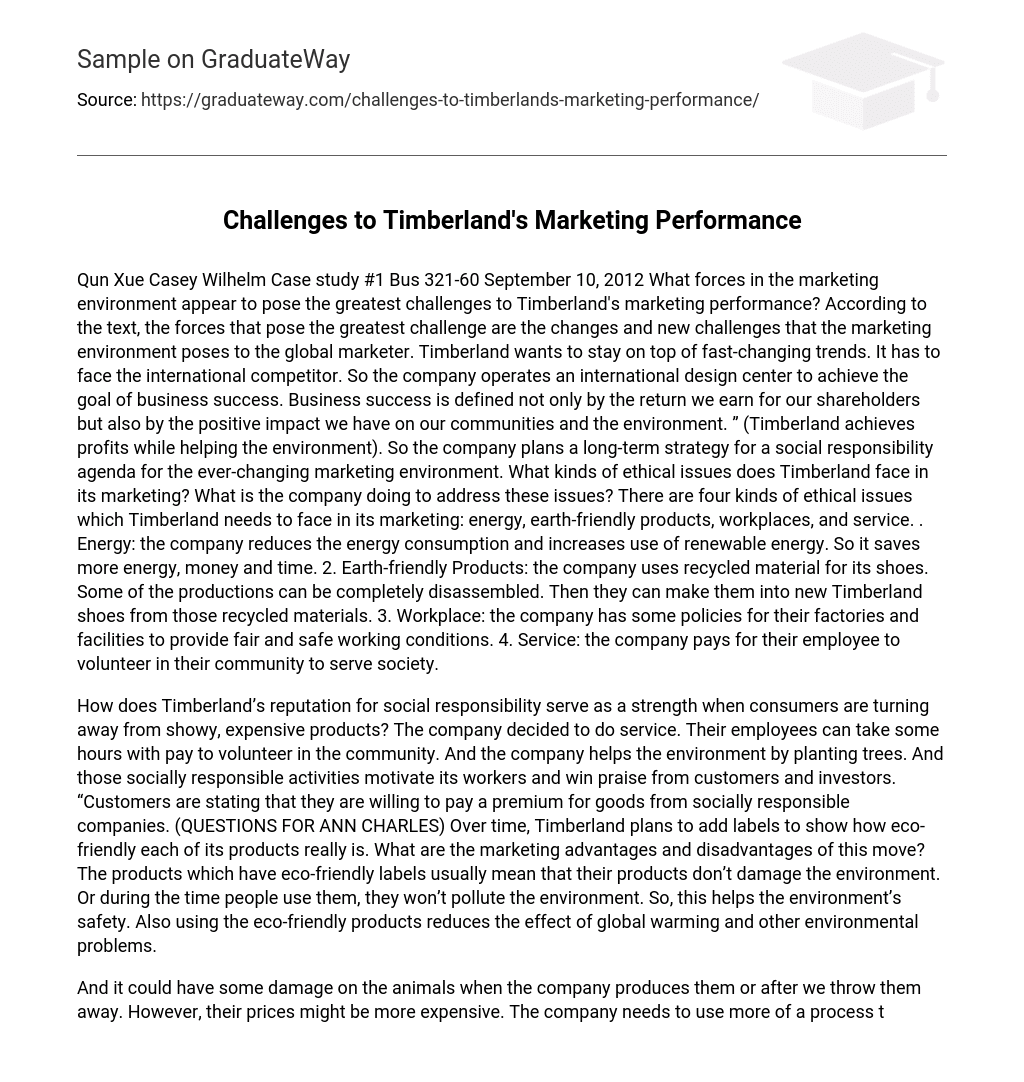Qun Xue Casey Wilhelm Case study #1 Bus 321-60 September 10, 2012 What forces in the marketing environment appear to pose the greatest challenges to Timberland’s marketing performance? According to the text, the forces that pose the greatest challenge are the changes and new challenges that the marketing environment poses to the global marketer. Timberland wants to stay on top of fast-changing trends. It has to face the international competitor. So the company operates an international design center to achieve the goal of business success. Business success is defined not only by the return we earn for our shareholders but also by the positive impact we have on our communities and the environment. ” (Timberland achieves profits while helping the environment). So the company plans a long-term strategy for a social responsibility agenda for the ever-changing marketing environment. What kinds of ethical issues does Timberland face in its marketing? What is the company doing to address these issues? There are four kinds of ethical issues which Timberland needs to face in its marketing: energy, earth-friendly products, workplaces, and service. . Energy: the company reduces the energy consumption and increases use of renewable energy. So it saves more energy, money and time. 2. Earth-friendly Products: the company uses recycled material for its shoes. Some of the productions can be completely disassembled. Then they can make them into new Timberland shoes from those recycled materials. 3. Workplace: the company has some policies for their factories and facilities to provide fair and safe working conditions. 4. Service: the company pays for their employee to volunteer in their community to serve society.
How does Timberland’s reputation for social responsibility serve as a strength when consumers are turning away from showy, expensive products? The company decided to do service. Their employees can take some hours with pay to volunteer in the community. And the company helps the environment by planting trees. And those socially responsible activities motivate its workers and win praise from customers and investors. “Customers are stating that they are willing to pay a premium for goods from socially responsible companies. (QUESTIONS FOR ANN CHARLES) Over time, Timberland plans to add labels to show how eco-friendly each of its products really is. What are the marketing advantages and disadvantages of this move? The products which have eco-friendly labels usually mean that their products don’t damage the environment. Or during the time people use them, they won’t pollute the environment. So, this helps the environment’s safety. Also using the eco-friendly products reduces the effect of global warming and other environmental problems.
And it could have some damage on the animals when the company produces them or after we throw them away. However, their prices might be more expensive. The company needs to use more of a process to produce or eliminate pollution. Also when the company develops the products, it could have unknown risks and reactions, so not every company wants to use that. “The other problem is that manufacturers are tempted to make exaggerated or misleading claims. ” (Advantages & Disadvantages of Eco-Branding) So it makes people misunderstand their choice of product.
Timberland SWOT Analysis: Strengths: * The company has strong brand recognition and a strong retail presence. Many people think Timberland symbolizes some type of shoes. It likes to get a reaction: when people mention boots, the first thing in people’s mind is Timberland. And consumers make the product out to be an adventurous brand. It also has good advertising. * The company uses scientific technology in the shoes’ production. The company designs some of its shoes to be renewable and recyclable materials. More than one-third of the products are made of recycled material. The company does well on squeezing its operations for saving more money, time and energy. That means the company can release more money from the operations. So the expenses could be less than before. * The company has a complete operating process from design to production. Therefore its industry chain won’t break easily or be more easily influenced by other factors. Weaknesses: * The company relies on overseas selling. Half of the company’s revenue comes from Europe and Asia. When the U. S. dollar’s value changes, it will affect the revenue on overseas trading. Rigorous competition in shoe marketing. There are more and more competitions in the world. * Focused market targets. There are a lot of customers who cannot buy their products, because they don’t have those shoes for the customer who has special request. Opportunities: * The company could expand its operations to new markets in US and UK, because their market could still be growing. * The company can also try some different marketing areas that are not only limited to outdoor sports. * The company can also sponsor some competition to help increase the brand’s popularity. Threats: The company faces the main challenge in which its target is outdoor wear. That is the limit the consumers have. * The company understands that there are lots of companies that offer a similar product throughout the world. * The company also faces the price challenge. In Costco and Wal-Mart, they have similar shoes that cost less money. Concern in this economy, even though the quality is different, but it is worth it to buy. Conclusion: Timberland has good and strong brand recognition. From the SWOT, the company still needs to find new growth marketing or develop a new marketing to operate.
References McCord, M. (2010. 5. 4). Timberland achieves profits while helping the environment. Retrieved from: http://www. seacoastonline. com/articles/20100504-NEWS- 5040309 Bennett, A. (2010. 11. 10). QUESTIONS FOR: ANN CHARLES. Retrieved from: http://responsibility-project. libertymutual. com/articles/questions-for-ann-charles#fbid=5oCMRbgmbsz Manda, G. (n. d. ). Advantages & Disadvantages of Eco-Branding. Retrieved from: http://www. ehow. com/info_8224132_advantages-disadvantages-ecobranding. html





